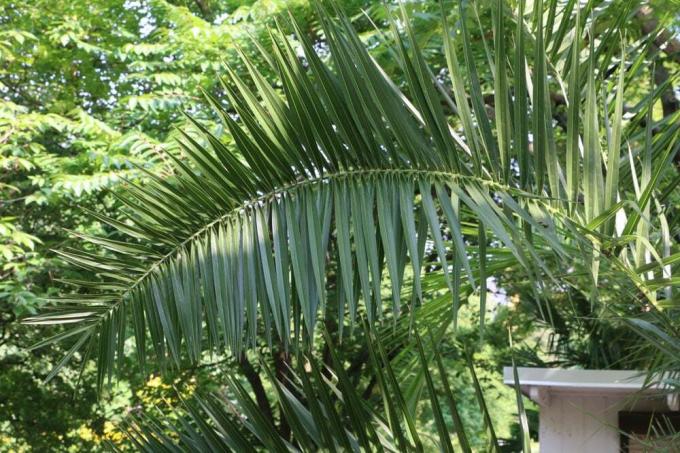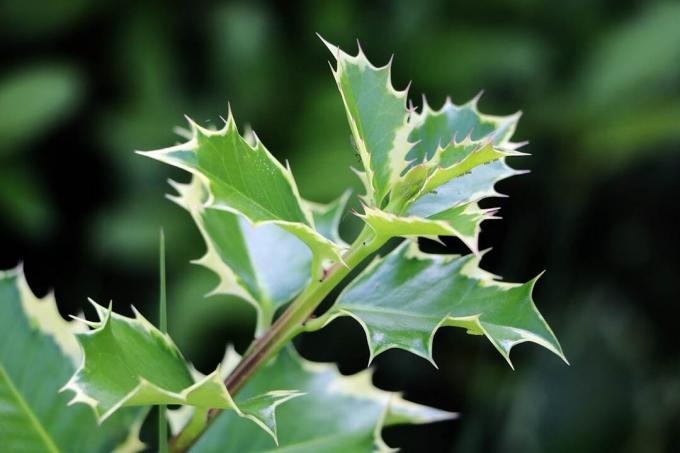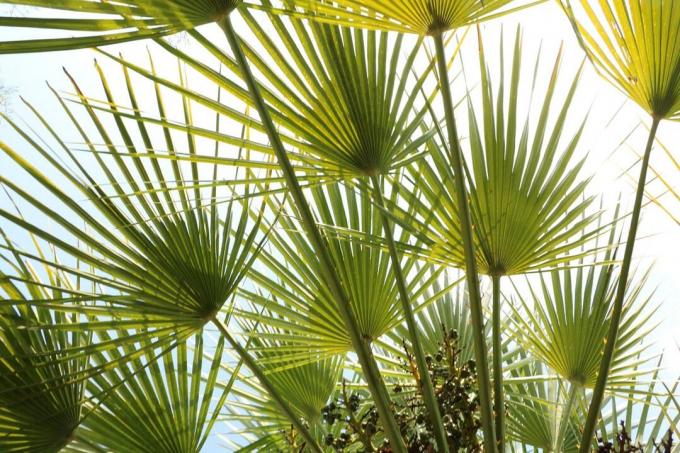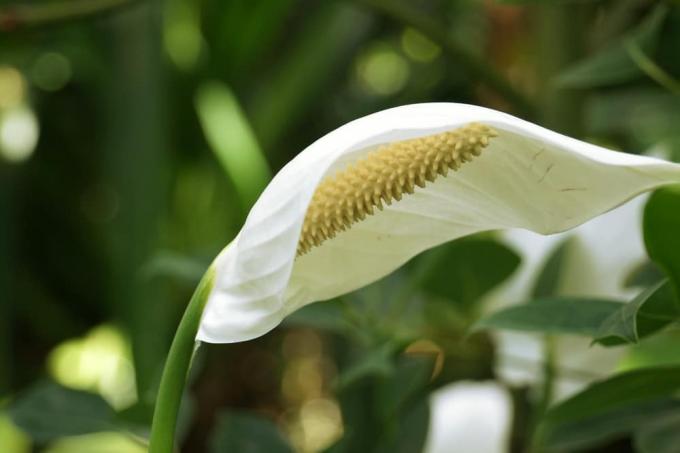

Table of contents
- Plant palm trees in the garden
- Frost hardy palms
- Location
- acclimatize
- Instructions for planting
- Properly repot palm trees in tubs
- Tips for winter protection
- Watering at frost
- Conclusion
palm trees in the snow; this picture presents itself more and more frequently in the local regions. In fact, the diverse palm family is home to a number of species and varieties that stand up to frost and snow. If the fundamental premises are met, such as the optimal location, the right type of palm tree and adequate winter protection, the ambassadors of southern flair will also thrive in your green kingdom. The following instructions explain specifically how to plant palm trees in the garden and how to repot them properly in tubs.
Plant palm trees in the garden
In order for the dream of a palm tree in the outdoor area to come true, the focus is on choosing a suitable species or variety. This results in the choice of location, and the planting work can begin. The following guide will provide you with the tools to succeed in this gardening challenge:
Frost hardy palms
These species and varieties have already proven to be excellent for year-round outdoor cultivation in beds and tubs:
Needle palm (Rhapidophyllum hystrix)
This palm adorns itself with the title of the hardest palm tree in the world. Decorative leaf fans rise above a short trunk, forming a mighty tuft. The upper sides are shiny green, while the undersides of the leaves shimmer silvery.
- Growth height up to 250 cm
- hardy to -24 degrees Celsius
Chinese Hemp Palm (Trachycarpus fortunei)
A particularly representative palm tree moves into your garden with this mighty specimen. The slender trunk is covered with a dense fiber coat. Above it is a huge crown of leaves with stiff fronds, which even stormy winds cannot harm.
- Growth height up to 12 meters
- hardy to -17 degrees Celsius
Dwarf palm (Chamaerops humilis 'Vulcano')
Perfectly suited for the small garden and the bucket, the dwarf palm scores with a compact habit. The pinnate green leaf fans form a dense tuft over a thornless trunk.
- Growth height up to 300 cm
- hardy to -15 degrees Celsius
This small selection may serve as inspiration when looking for the ideal palm tree for your garden.
Tip:
Palms that are at least 4 years old and 50 centimeters tall are more suitable for outdoor cultivation than smaller or younger specimens.
Location
In order for palm trees to feel comfortable in your garden, a location with the following conditions should be considered:
- Full sun, preferably 1-3 meters from a heated building
- Sheltered from wind and rain, in the shelter of a wall or a hedge
- Humus soil, preferably loamy-sandy and not too dry
- Loose and well-drained, with no risk of waterlogging
- Ideally with a pH of 5.3 to 7.0
A place in the immediate vicinity of the house - not necessarily on the weather side - is therefore desirable if you plant palm trees in the garden.
acclimatize
Once you have chosen your favorite hardy palm trees, they will need some time to acclimatize outdoors. The plants were mostly cultivated behind glass, like large greenhouses, and spent a longer period in hardware stores and garden centers with little light. Directly confronted with the blazing sun, the palm trees suffer sunburn. Although this is not life-threatening, it does damage the optics considerably. Choose between one of the two alternatives to allow the plants to acclimate in the garden:
- Plant in the chosen location immediately after purchase and shade with a parasol for a week
- Harden off in the bucket for one to two weeks in a semi-shady place and only then plant out
Instructions for planting
If no hard frost periods are to be expected in spring, you can plant palm trees in the garden from March. In this way, the plants have enough time to take root in the soil and produce new leaves. Follow these steps:
- Dig a planting pit with twice the volume of the root ball
- Enrich the excavation with compost, peat, leaf soil, horn shavings and, if necessary, some sand
- At the wetter location, drainage made of grit prevents harmful waterlogging
- Fill in the optimized excavation or special palm soil in a 15 cm layer
- Unpot the palm tree, place it in the middle of the planting hole and plant it
In the end, the root ball should be just as deep in the substrate as it was in the pot. Ideally, the tree disc is a few centimeters below the surrounding earth surface. This pouring rim optimizes the utilization of the irrigation water. Water regularly and plentifully during the growth phase to support rooting.
Properly repot palm trees in tubs

If your palm trees have survived the cold season well in a sheltered location in the garden or winter quarters, spring is the best time to move to a larger bucket. This is necessary when the taproots take up all of the space available in claim, push yourself up through the substrate or out of the bottom opening outgrow Choose the new planter just a few centimeters larger in diameter and depth. Otherwise, the palm tree will first invest all its energy in rooting the new pot. This process occurs at the expense of height and leaf growth. How to repot correctly:
- Lay a drainage in the ground made of chippings or potsherds over the water drain
- An air- and water-permeable fleece prevents earth crumbs from settling here
- Fill the lower third of the bucket with high-quality palm soil
- Alternatively, make a mix of 1 part each of compost, garden soil and peat
- Additives such as perlite, expanded clay, sand or styrofoam balls improve permeability
- Place the potted palm tree in the middle of the bucket and surround it with substrate
As you pour in the substrate, press it down repeatedly with your fist to prevent voids from forming. A pouring edge of 3-4 centimeters prevents wet soil from spilling over later. Finally, pour penetratingly.
Tips for winter protection
To ensure that palm trees in beds and tubs are not damaged in winter, the following precautions are recommended.
- Cover the root area thickly with leaves, straw, needle brushwood or bark mulch
- Tie the leaves loosely together in several bundles with raffia or sisal
- In severe frost, wrap the trunks with jute or reed mats
- Wrap the tub in bubble wrap and place on wood or polystyrene
- Pack small palm trees completely in fleece or foil with a hand's breadth distance to the crown and trunk
- As soon as temperatures rise, remove any winter protection immediately
In regions with consistently severe winter frosts, prudent hobby gardeners prevent possible damage when planting in the garden. To do this, a square planting hole is dug that is 30 centimeters larger in width and depth than the root ball. The walls of the pit are lined with 5 cm thick hard foam panels. However, the floor must not be laid out with the material. In this way you create a self-made vacuum bucket. Then plant the palm tree as described.
Watering at frost
All efforts to successfully overwinter palm trees in the garden are ineffective if the plants dry up. In fact, far more plants suffer from drought stress in winter than in summer. If frost occurs during the cold season, sub-zero temperatures prevail, while at the same time there is no insulating snow cover. Since the roots in the frozen ground do not have access to liquid water and there is no supply from above either, they are in danger of drying out. On frost-free days, the palm trees in the garden and in the tub should be watered.
Conclusion
If you want to give your garden an exotic touch, you can easily plant palm trees in the garden. There is a wide range of hardy species and varieties available, all of which tolerate the deepest sub-zero temperatures. With the choice of a sunny, sheltered location in slightly acidic garden soil, the prospects for successful cultivation are excellent. If you plant according to these instructions, the tropical gems will happily take root. If you prefer to cultivate palm trees in planters, you can create a relaxing holiday feeling on the terrace and balcony all year round. However, a change to the next larger pot is unavoidable every few years. This reading material therefore provides you with the tools to properly repot palm trees in pots. Since the winter time is the ultimate challenge for all outdoor palm trees, the tips for Winter protection make a contribution to ensure that you can enjoy the majestic plants for many years to come receive.
 garden editorial
garden editorial I write about everything that interests me in my garden.
Learn more about Exotic Plants

Holly, holly: care from A to Z
The European holly is one of the evergreen plants. It reaches a height of up to five meters and is ideal as a Christmas decoration or garden shrub. The native, although rarely occurring plant is the only native representative of the Ilex family and is particularly easy to care for and robust.

Dwarf palm, Chamaerops humilis: care instructions
The dwarf palm remains small enough that it can also be cared for in the room. However, it also cuts a fine figure in the garden. You can find out here how it is maintained and what needs to be considered.

Dwarf date palm, Phoenix roebelenii: Care from A-Z
The dwarf date palm (Phoenix roebelenii) is a particularly small, actually the smallest palm species of its genus. But that doesn't make them any less decorative. It is the most filigree and elegant date palm and hardly grows higher than one meter.

Growing vanilla plants: 11 tips for care
The vanilla plant is truly exotic in Central Europe and cannot be found in every garden. Vanilla planifolia forms the aromatic pods for which the plant is known. The cultivation of a vanilla plant is easily possible with the right care tips.

Kangaroo Paw: Caring for the kangaroo plant
Kangaroo paws are exotic plants native to southwestern Australia. Considering the care instructions, Kangaroo Paw can also thrive in Central European conditions. Maintenance requires a little more effort. If the plant gets enough attention, it will thank you with magnificent inflorescences.

Einblatt, Spathiphyllum: care from A to Z
Because of simple! The single sheet draws everyone's attention with its extravagant appearance. The imposing flower gives sophisticated rooms that certain something. If the houseplant is in the right place, hardly any care is required. The breeder can find out here what demands Spathiphyllum places on their location.

